The Unreliable Bestiary is presenting a performance for every letter of the alphabet—each letter representing a particular endangered animal or habitat. Using our human relationships with these creatures as a lens, the Bestiary project focuses on the severely challenged life systems of the planet. We do this through contemporary stories, myth, and unusual immersive events. We’ve made six shows so far: MONKEY, ELEPHANT, WOLF, BEAR, TIGER, and CETACEAN (The Whale). I’m sixty years old. It’s unlikely that I’ll be around for twenty more performances. Maybe it could become something curricular after I’m in the ground. Each show has taken around three years to make and lots of research: science, folklore, interviews, national parks. The fieldwork helps me realize that animals and our stories about them are embedded in environmental, economic, spiritual, and political systems—the systems thoroughly entangled with each other. It’s all part of the same cloth. You tug on one corner of the bed sheet and the whole thing moves.
The Speculative Ecologies of The Unreliable Bestiary
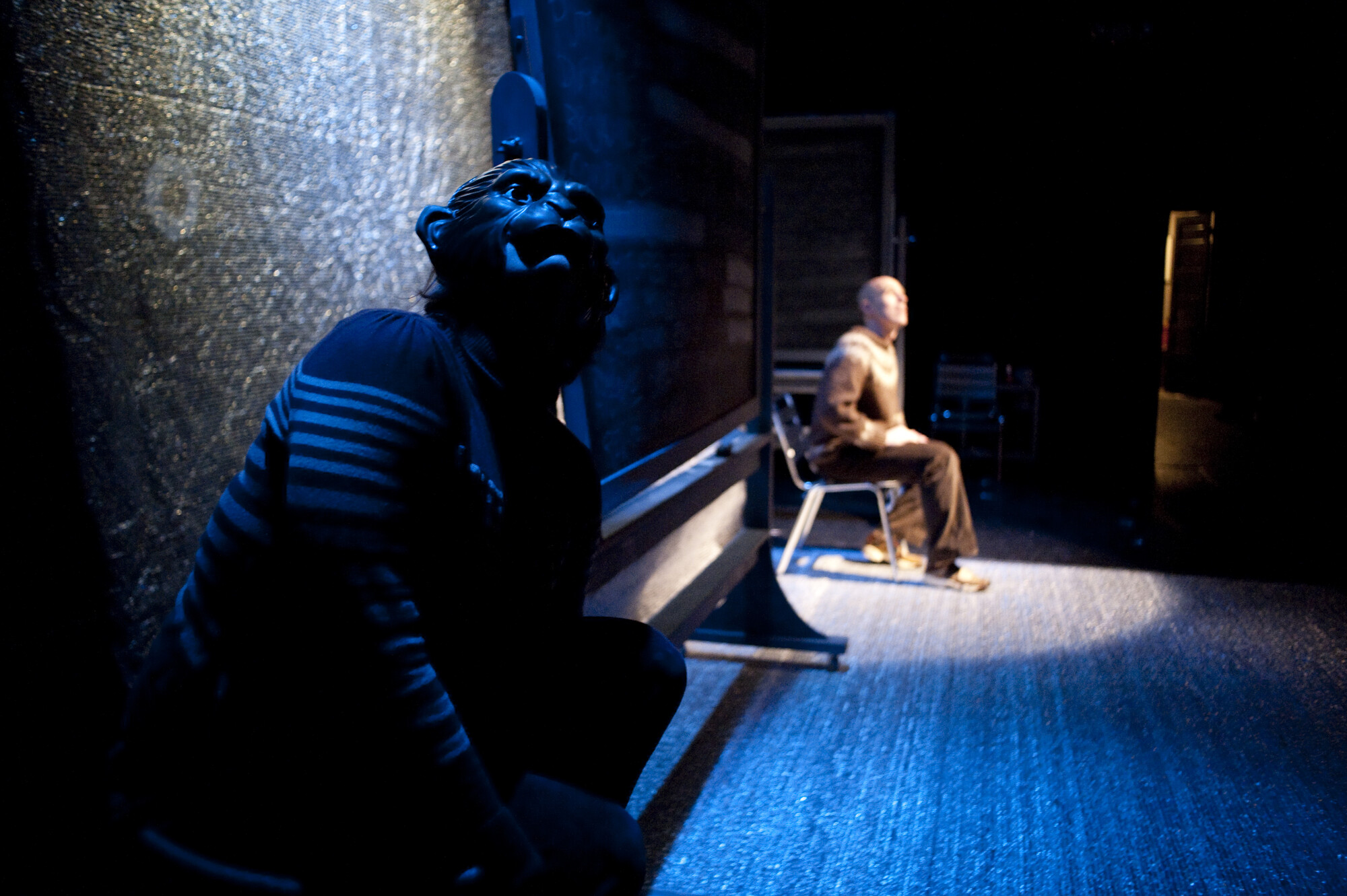
Jennifer Allen and Deke Weaver in MONKEY by Deke Weaver/The Unreliable Bestiary. Directed by Jennifer Allen. Production design by Andy Warfel. Dramaturgy by Jayne Wenger. Lighting design by Susan Hudson. Stage management by Valerie Oliveiro. Video/Sound design by Deke Weaver. Peformer-techs Sam Gusfield and Jeff Kolar. Photo by Valerie Oliveiro.
In 2005, I got a job at the University of Illinois in Champaign. Jennifer Allen and I moved here from New York. We opened MONKEY, our first collaboration, in a black box theatre on Darwin’s 200th birthday in 2009. Jen’s got a history of downtown NYC dance and choreography. My visual arts undergrad work turned towards performance in grad school, leading me to San Francisco’s solo performance world in the nineties. For the Bestiary shows, we wear lots of different hats, but generally, I write and perform, and Jen directs and performs.
The scale of ELEPHANT in 2010 was something new for all of us. Core team members have included dramaturg Jayne Wenger (who I’ve worked with for thirty years), costume designer Susan Becker, and production designer Andy Warfel. Staged in a cavernous livestock pavilion, ELEPHANT featured video projected on two ninety-foot-long screens, stop-motion animation, live sound, monologs, dance, and a twelve-foot-high life-sized elephant puppet. The size of the show echoed the enormity of the animal. We juxtaposed the stories of Hero, a circus elephant who was shot down in a 1916 South Dakota blizzard, and Jojo, an elephant Jennifer and I came to know at the Thai Elephant Conservation Centre in northern Thailand.

Deke Weaver, Stevie May, Kyli Kleven, Jennifer Allen, Jessica Cornish and Jojo the elephant in ELEPHANT by Deke Weaver / The Unreliable Bestiary. Directed by Jennifer Allen. Sound design/composition by Chris Peck. Production design by Andy Warfel. Associate environmental design by Grant Bowen. Dramaturgy by Jayne Wenger. Lighting design by Valerie Oliveiro Costume Design by Susan Becker. Video design by Deke Weaver. Stage manager Elina Kotlyar. Photo by Valerie Oliveiro
Is it true that elephants use their ears to billow intoxicating perfumes towards potential lovers?
Yes. It is true.
If ELEPHANT felt like a circus, 2013’s WOLF felt like a campfire. We took audiences over the river and through the woods on a forty-minute ranger-guided bus tour. Just as the sun was setting, the buses arrived at Allerton Park, a small 2.37 square mile forest near Monticello, an Illinois farm town. The journey mimicked the six-hour boat ride from Michigan’s Upper Peninsula to Isle Royale National Park, the site of the world’s longest predator-prey study (wolves/moose). After being informed that wolves had been introduced into the forest, rangers divided audiences into four herds (Deer, Moose, Elk, Bison), insisted on silence, and led the herds into the woods. As the sky went dark, the herds looked for wolves… and found them.
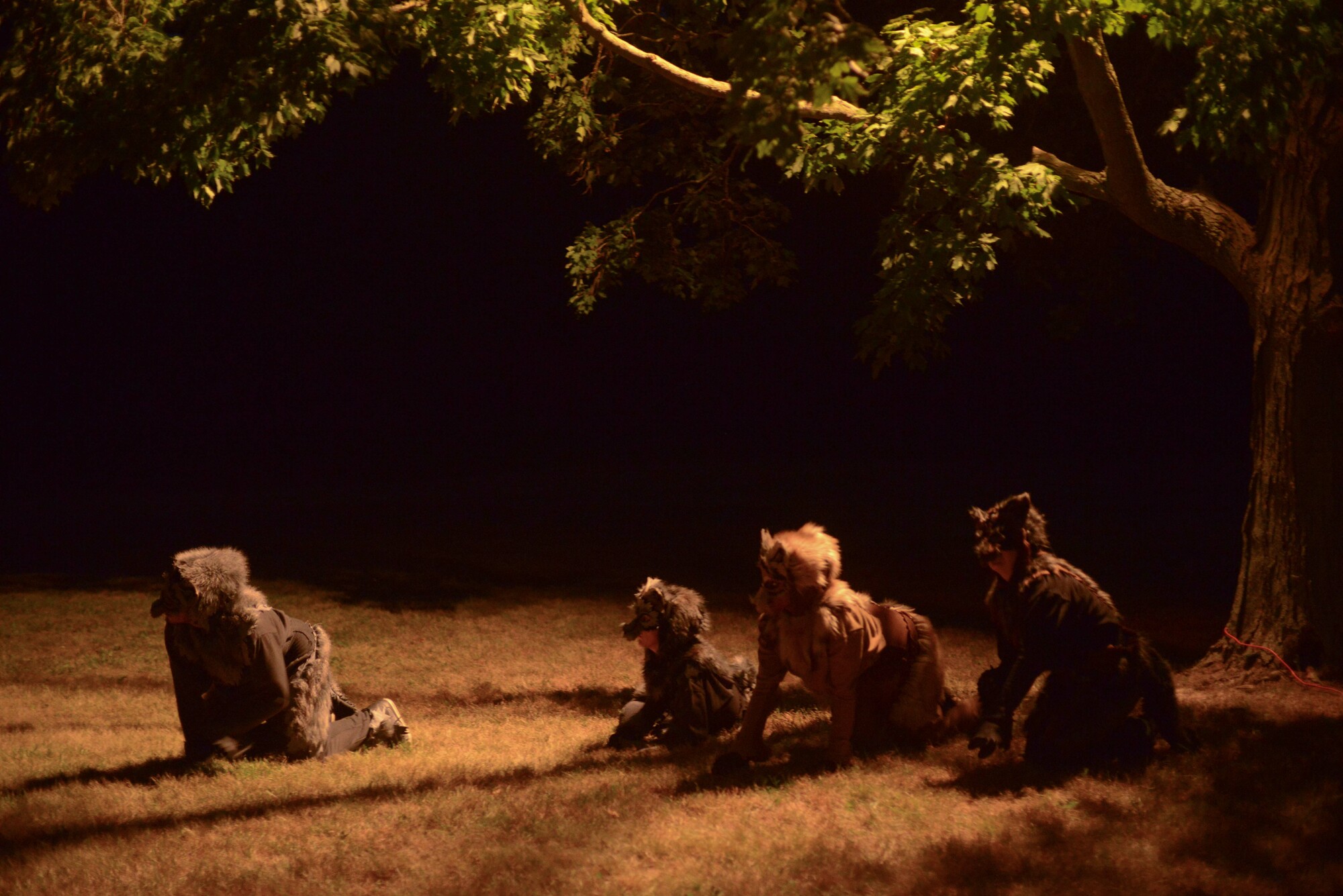
Jennifer Allen, Nico Brown, Laura Chiaramonte, Jessica Cornish, Niall Jones, and Angie Pittman in WOLF by Deke Weaver/The Unreliable Bestiary. Directed by Jennifer Allen. Sound design/composition by Chris Peck. Production design by Grant Bowen. Dramaturgy by Jayne Wenger. Lighting design by Valerie Oliveiro. Costume Design by Susan Becker. Video design by Deke Weaver. Sound/video operation by Bradford Chapin. Light board operation by Hali Linn. Artists: Nicki Werner, Maria Lux, Jason Patterson and many others. Stage management by Nicki Werner. Photo by Valerie Oliveiro.
Wolves were hunted out of Yellowstone National Park’s 3,471 square miles by the mid-1920s. Without the top predators, the natural systems started to shift, literally changing the course of the rivers in the park. Scientists started pushing to reintroduce wolves to settle the big ecosystem. Ranchers fought back. It got so heated there were meetings where folks wore bullet-proof vests. It was a microcosm of some of the politics we’re swimming in now.
Forty-one wolves were released into Yellowstone between 1995 and 1997. In the nearly thirty years since, everything science predicted has come to pass. Success! Sure, there are ranchers that would beg to differ. And there are folk who hate wolves just as much as their pre-1920 ancestors. But for the trees, rivers, elk, beavers, and fish… everybody’s healthier. Even the bears are feeling better. Since 2009, wolf numbers in the park have fluctuated between 108 and 123. So, success!
The audience became more than passive observers. They rode out to Allerton singing and howling.
I loved reading James Westcott’s review of Deborah Warner’s 2003 site-specific-performance-installation The Angel Project, where some small parts of a New York treasure-hunt were choreographed, but most parts (the entire city) were not. Sometimes the bits that were not choreographed became as charged as the intended parts. When those parts worked for the seeker on the trail, the whole world started to shimmer. At times we found that sweet spot with WOLF’s chronically underfunded, teensy national park and its cultish underbelly. Inspired by the Yellowstone story, we introduced our own wolves to Allerton—a tiny patch of old growth forest with a river running through it; a very real, thriving island of wildness in a twenty-seven million acre sea of mono-crop industrial agriculture. The wolf-introduction was fiction. Our wolves were dancers in costume. But, somehow, to this day—yes, eleven years later—there are people who believe that there are wolves in Allerton. The show culminated in a barn filled with video, dance, music, and stories. The audience became more than passive observers. They rode out to Allerton singing and howling. They hiked into the dark and became part of the journey.
Sometimes these shows take people to places that they’ve been before, where we make the familiar unfamiliar. Maybe like Borges’ On Exactitude in Science where “the Cartographers Guilds struck a Map of the Empire whose size was that of the Empire, and which coincided point for point with it… In the Deserts of the West, still today, there are Tattered Ruins of that Map, inhabited by Animals and Beggars …” The Bestiary’s tattered maps offer speculative ecologies to help us see our own ecologies with new eyes.
Is it true that the loss of the ocean’s apex predators could disrupt the balance of entire marine ecosystems and threaten the food security of many countries?
Yes, it is true.
BEAR’s hibernation meditation was based in three parts. The fall 2016 chapter led groups of twelve on silent walking tours of six bear-related installations (one for each month the bear lives above ground) scattered through a small wild park. The final installation crawled audiences through a barn’s winding tunnel to a small dimly lit den’s bear-man telling his story. The winter chapter featured six online videos, one video for each month the bear hibernates. The videos gave directions to geocached information that folks had to go out and find in two different parks—oversized puzzle pieces that built a map which led to the University of Illinois Rare Book and Manuscript Library. A code word from the audience member launched the librarians into their own performance—a presentation of very old bear-related books, star maps, journals, and reliquaries. The spring 2017 chapter sat audiences at a huge, long table covered with cakes, wine, and candles. Two intertwining stories were told—a human becoming a bear, a bear becoming a human. Set in a future of post-climate collapse, BEAR’s desperate, magical thinking was built with recycled scrap, wind/hand-crank/solar power, and gallows humor.
Is it true that more tigers are kept as pets in the state of Texas than there are wild tigers left on the planet?
Yes. It is true.
2019’s solo TIGER show opened with a marketing survey, an extension of an actual, peer-reviewed study—an attempt to find the world’s most charismatic animal by ranking fifteen attributes. Fluffiness was included as an attribute because “fluffiness often appears to be associated with a species’ ‘cuteness.’” The choices for grading fluffiness were “None,” “Some,” and “Extreme.” According to this study, tigers are the world’s most popular animal. This could be useful for big environmental institutions… or oil companies. The show charted Exxon-Mobil’s support of the Save the Tiger Fund, while the company and its former mascot—a cartoon tiger—helped destroy the habitat of the last real wild tigers on Earth.
Is it true that a mother blue whale’s milk is so rich that her baby will put on 250 pounds a day?
Yes. It is true.
Over eight hundred students listed their hopes and fears in eighteen months of CETACEAN workshops. We talked about oceans, whales, eco-anxiety, and interconnectivity. Students burned the lists of fear, made origami stars from the lists of hope, and filled thousands of discarded plastic bottles with the ash of fear and the stars of hope. Rooted in these workshops, 2023’s CETACEAN evolved into a performance collage of lo-fi effects, dance, video, sound design, and an ocean of messages-in-a-bottle suspended over the heads of the audience—we told our stories under a plastic sea of hope and fear.
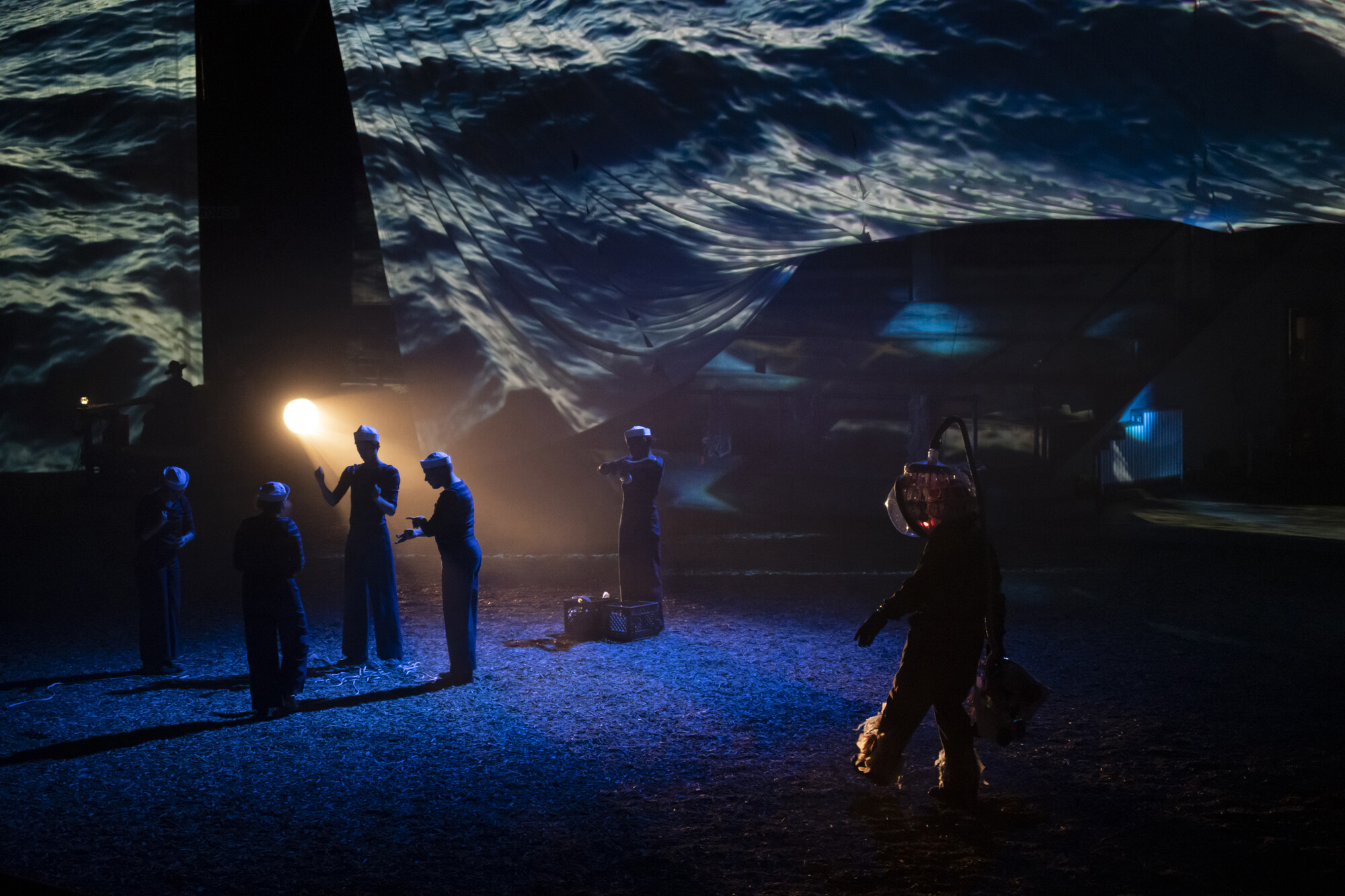
Laura Chiaramonte, Jennifer Allen, Gabriel Gonzalez, Jacob Henss, Adanya Gilmore, and Deke Weaver in CETACEAN (The Whale) by Deke Weaver/The Unreliable Bestiary. Directed by Jennifer Allen. Dramaturgy by Jayne Wenger. Production design by Andy Warfel. Technical direction by Blane Friest. Sound design by James Lo. Costume Design by Susan Becker. Scenic design by Phil Orr and Melissa Pokorny. Lighting design by Robert Perry. Video design by John Boesche. Stage management by Sidney Sprunger and Joshua Stenger. Photo by Nathan Keay.
When we started making these shows fifteen years ago, the Bestiary took pleasure sliding in the slippery results of the scientific method. Seeking answers and objectively establishing facts through tests and experimentation takes time. Capitalist society’s acceptance of what has been learned, and adjusting and changing its understanding of the world, seems to take even longer. There are things that were once thought to be true, but are no longer true, like this excerpt from Pliny the Elder’s Natural History (77 AD)…
Elephants bloud is exceeding cold, and therefore the dragons be wonderfull desirous thereof to refresh and coole themselves therewith, during the parching and hote season of the yeere … these dragons are so big withall, that they be able to receive all the Elephants bloud. Thus are they sucked drie, untill they fall down dead: and the dragons again, drunken with their bloud, are squised under them, and die both together.
Then there are things that sound like there is absolutely no way they could be true… but, actually, they are. The United States of America men’s 2014 World Cup starting eleven weighed a total of 849 kg/1872 lbs. Large male polar bears can weigh over 771 kg /1700 lbs. The largest polar bear ever recorded stood 11 feet high and weighed 1002 kg/2210 lbs… that’s 153 kg/337 lbs more than the entire 2014 United States men’s soccer team.
Really? That’s amazing.
2006’s film An Inconvenient Truth contains many predictions. Most of them have come true. Mountains are on fire, islands are drowning, but evangelicals don’t seem to be haling Al Gore as a prophet. With the grim march of global disinformation, it feels less fun to play with the truth than it did fifteen years ago. Building moments of uncertainty where audiences wonder, “Really? Is that true?” used to be part of the game, but now it feels like you have to spell it out: “My friends? This is not true. Do you understand what I’m saying? Can you see that it’s not true?”
Is it true that micro plastics have been discovered in the freshly fallen snow of Antarctica and the bloodstream of newborn Italian babies?
Yes. It is true.
If you hang a gun on the wall in the first act, you better use it in the second. Right? The audience sees the gun. It’s a threat we understand—direct, immediate, easy to care about, easy to believe. It’s hard to care about slowly melting glaciers, hard to worry about the quiet cancer cluster, about the suffering that happens off-stage. It’s hard to worry about the invisible, slow degradation of the earth’s living systems. If you haven’t personally experienced something, maybe it doesn’t exist? Why does the extinction of non-human creatures on the other side of the world matter? This question comes up with all the Bestiary performances—how to create stories that have the clarity of the gun as opposed to the insidious creep of climate change and petrochemicals. These days, even if it’s clear as a bell, it might not be believed to be true.
Well, Chekhov’s guns seem to be everywhere and we’re in the second act. But guns are only one of the problems. A “black elephant” is a cross between “a black swan” (an unlikely, unexpected event with enormous ramifications) and the “elephant in the room” (a problem visible to everyone that no one wants to address). In 2014, environmentalist Adam Sweidan pointed out that there was a “herd of environmental black elephants” on the brink of stampede: global warming, deforestation, ocean acidification, massive freshwater pollution, and mass extinction. Sweidan said, “When they hit, we’ll claim they were black swans no one could have predicted, but, in fact, they are black elephants, very visible right now.”
Like water and air, the human imagination is elemental to natural systems.
So, here we are, 2024. This environmental herd is in full stampede. Naomi Klein has said,
We live in a time of multiple overlapping intersecting crises. We have to figure out how to multitask, which means we need to figure out how to lower emissions in line with what scientists are telling us. And we need to do it in a way that builds a fair economy in the process. Because if we don’t figure out a way to deal with climate change that doesn’t ask people to choose between the need to put food on the table… and the need to safeguard the living systems on which all of life depends, we’re going to lose.
This moment requires varied tactics and voices from all quarters. The Unreliable Bestiary’s small local voice is finding ways to talk about the elephant in the room. Through our rich, emotional stories of animals, climate, and people, we’re creating experiences that subtly draw out the connections between wildly disparate local and global dots, experiences that continue to illustrate how the personal is political. By making environmental, psychological, social degradation tangible and present, by linking these stories to cultural origin myths and our fantasies of the future, remixing them, rewriting them, weaving them from whole cloth and telling them in unusual contexts—we hope to remove our audiences from the daily grind and wake them up. Like water and air, the human imagination is elemental to natural systems. It transforms things. We work with humor and the absurd; music and silence; people and wonder. Our live performances quietly insist on re-enchantment and the dismantling of the status quo.
And that’s where I should leave it. Stick the landing, cue the swelling string section, and we all go home recognizing that that’s the bit that is supposed to be hopeful (with the understanding that maybe it’s not).
But…but… is it enough? Of course not. What’s enough? Is this how you change “The Story?” Does any of this cultural chatter actually matter? Is it true that our performances and plays and stories are needed as much as science-based-policy? Sometimes it feels like it, sure. But sometimes after spending all day telling students that what we do matters, and it’s not a great day, and I don’t believe myself for a second, I go home and pull the sheets up over my head at 7:30pm. Fuck. There’s so much that feels hopeless.
But I’ll get up the next morning. Let’s all get up the next morning. And start again.

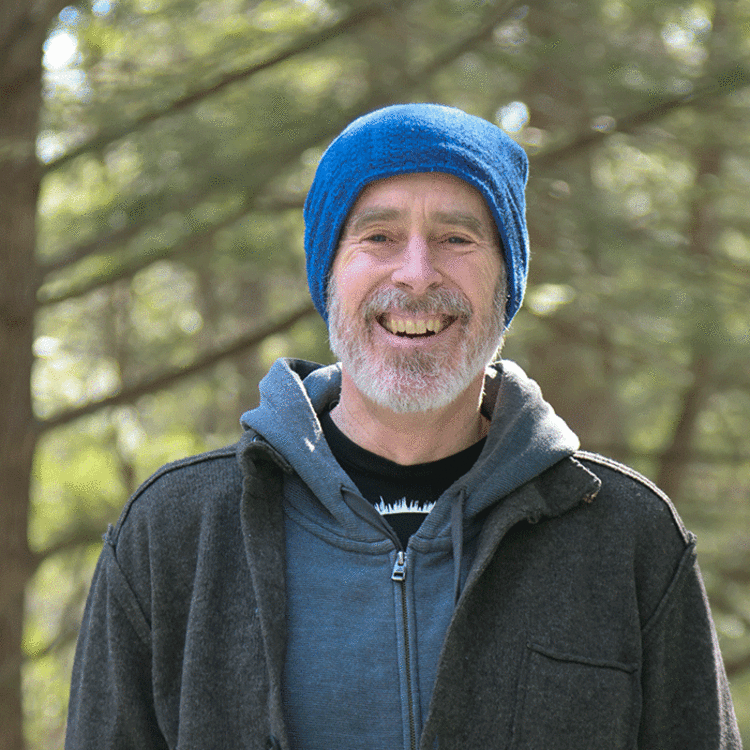



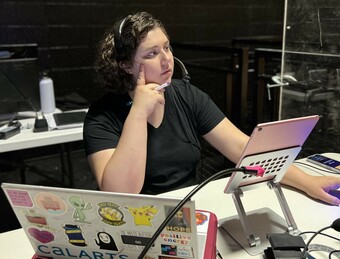

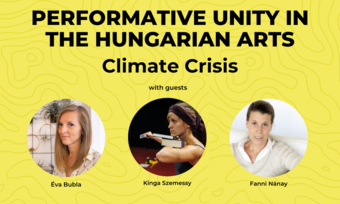





Comments
The article is just the start of the conversation—we want to know what you think about this subject, too! HowlRound is a space for knowledge-sharing, and we welcome spirited, thoughtful, and on-topic dialogue. Find our full comments policy here